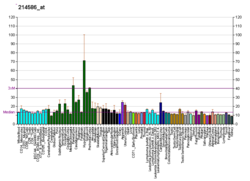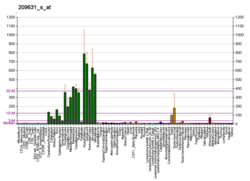GPR37 Identifiers Aliases GPR37 External IDs OMIM : 602583 MGI : 1313297 HomoloGene : 3875 GeneCards : GPR37 Gene location (Human ) Chr. Chromosome 7 (human) [1] Band 7q31.33 Start 124,743,885 bp [1] End 124,765,792 bp [1]
Gene location (Mouse ) Chr. Chromosome 6 (mouse)[2] Band 6 A3.1|6 11.65 cM Start 25,665,877 bp [2] End 25,690,728 bp [2]
Gene ontology Molecular function Cellular component Biological process Sources:Amigo / QuickGO
Orthologs Species Human Mouse Entrez Ensembl UniProt RefSeq (mRNA) RefSeq (protein) Location (UCSC) Chr 7: 124.74 – 124.77 Mb Chr 6: 25.67 – 25.69 Mb PubMed search[3] [4] Wikidata
Probable G-protein coupled receptor 37 is a protein that in humans is encoded by the GPR37 gene .[5] [6]
Interactions [ ] GPR37 has been shown to interact with HSPA1A [7] Parkin (ligase) .[7] [8] prosaposin . It was previously thought to be a receptor for , a neuropeptide found in the hydra , but early reports of head activator in mammals were never confirmed.[9]
GPR37 signaling has been shown to modulate the migration of olfactory ensheathing cells (OECs) and gonadotropin-releasing hormone (GnRH) cells in mice.[10]
References [ ]
^ a b c GRCh38: Ensembl release 89: ENSG00000170775 - Ensembl , May 2017^ a b c GRCm38: Ensembl release 89: ENSMUSG00000039904 - Ensembl , May 2017^ "Human PubMed Reference:" . National Center for Biotechnology Information, U.S. National Library of Medicine .^ "Mouse PubMed Reference:" . National Center for Biotechnology Information, U.S. National Library of Medicine .^ Marazziti D, Golini E, Gallo A, Lombardi MS, Matteoni R, Tocchini-Valentini GP (November 1997). "Cloning of GPR37, a gene located on chromosome 7 encoding a putative G-protein-coupled peptide receptor, from a human frontal brain EST library". Genomics . 45 (1): 68–77. doi :10.1006/geno.1997.4900 . PMID 9339362 . ^ "Entrez Gene: GPR37 G protein-coupled receptor 37 (endothelin receptor type B-like)" .^ a b Imai Y, Soda M, Hatakeyama S, Akagi T, Hashikawa T, Nakayama KI, Takahashi R (July 2002). "CHIP is associated with Parkin, a gene responsible for familial Parkinson's disease, and enhances its ubiquitin ligase activity" . Molecular Cell . 10 (1): 55–67. doi :10.1016/S1097-2765(02)00583-X PMID 12150907 . ^ Imai Y, Soda M, Inoue H, Hattori N, Mizuno Y, Takahashi R (June 2001). "An unfolded putative transmembrane polypeptide, which can lead to endoplasmic reticulum stress, is a substrate of Parkin" . Cell . 105 (7): 891–902. doi :10.1016/S0092-8674(01)00407-X PMID 11439185 . S2CID 721363 . ^ Meyer, Rebecca C.; Giddens, Michelle M.; Schaefer, Stacy A.; Hall, Randy A. (4 June 2013). "GPR37 and GPR37L1 are receptors for the neuroprotective and glioprotective factors prosaptide and prosaposin" . Proceedings of the National Academy of Sciences . 110 (23): 9529–34. Bibcode :2013PNAS..110.9529M . doi :10.1073/pnas.1219004110 PMC 3677493 PMID 23690594 . ^ Saadi H, Shan Y, Wray S (2019). "GPR37 Signaling Modulates Migration of Olfactory Ensheathing Cells and Gonadotropin Releasing Hormone Cells in Mice" . Frontiers in Cellular Neuroscience . 13 : 200. doi :10.3389/fncel.2019.00200 PMC 6521704 PMID 31143101 .
Further reading [ ]
Zeng Z, Su K, Kyaw H, Li Y (1997). "A novel endothelin receptor type-B-like gene enriched in the brain". Biochemical and Biophysical Research Communications . 233 (2): 559–67. doi :10.1006/bbrc.1997.6408 . PMID 9144577 . Donohue PJ, Shapira H, Mantey SA, Hampton LL, Jensen RT, Battey JF (1998). "A human gene encodes a putative G protein-coupled receptor highly expressed in the central nervous system" . Molecular Brain Research . 54 (1): 152–60. doi :10.1016/S0169-328X(97)00336-7 . PMID 9526070 . Imai Y, Soda M, Inoue H, Hattori N, Mizuno Y, Takahashi R (2001). "An unfolded putative transmembrane polypeptide, which can lead to endoplasmic reticulum stress, is a substrate of Parkin" . Cell . 105 (7): 891–902. doi :10.1016/S0092-8674(01)00407-X PMID 11439185 . S2CID 721363 . Imai Y, Soda M, Hatakeyama S, Akagi T, Hashikawa T, Nakayama KI, Takahashi R (2002). "CHIP is associated with Parkin, a gene responsible for familial Parkinson's disease, and enhances its ubiquitin ligase activity" . Molecular Cell . 10 (1): 55–67. doi :10.1016/S1097-2765(02)00583-X PMID 12150907 . Yang Y, Nishimura I, Imai Y, Takahashi R, Lu B (2003). "Parkin suppresses dopaminergic neuron-selective neurotoxicity induced by Pael-R in Drosophila" . Neuron . 37 (6): 911–24. doi :10.1016/S0896-6273(03)00143-0 PMID 12670421 . S2CID 8430695 . Imai Y, Soda M, Murakami T, Shoji M, Abe K, Takahashi R (2003). "A product of the human gene adjacent to parkin is a component of Lewy bodies and suppresses Pael receptor-induced cell death" . Journal of Biological Chemistry . 278 (51): 51901–10. doi :10.1074/jbc.M309655200 PMID 14532270 . Kubota K, Niinuma Y, Kaneko M, Okuma Y, Sugai M, Omura T, Uesugi M, Uehara T, Hosoi T, Nomura Y (2006). "Suppressive effects of 4-phenylbutyrate on the aggregation of Pael receptors and endoplasmic reticulum stress" . Journal of Neurochemistry . 97 (5): 1259–68. doi :10.1111/j.1471-4159.2006.03782.x PMID 16539653 . S2CID 24540976 . Omura T, Kaneko M, Okuma Y, Orba Y, Nagashima K, Takahashi R, Fujitani N, Matsumura S, Hata A, Kubota K, Murahashi K, Uehara T, Nomura Y (2006). "A ubiquitin ligase HRD1 promotes the degradation of Pael receptor, a substrate of Parkin" (PDF) . Journal of Neurochemistry . 99 (6): 1456–69. doi :10.1111/j.1471-4159.2006.04155.x . hdl :2115/17141 PMID 17059562 . S2CID 6256027 .
Cell surface receptor : G protein-coupled receptors
Neurotransmitter
Adrenergic
α1 (A B D )α2 (A B C )β1 β2 β3 Purinergic
Adenosine (A1 A2A A2B A3 )P2Y (1 2 4 5 6 8 9 10 11 12 13 14 ) Serotonin Other
Acetylcholine (M1 M2 M3 M4 M5 )Dopamine
GHB receptor Histamine
Melatonin (1A 1B 1C )TAAR (1 2 5 6 8 9 )
Metabolites and
Eicosanoid
CysLT (1 2 )LTB4
FPRL1 OXE Prostaglandin
DP (1 2 ), EP (1 2 3 4 ), FP Prostacyclin Thromboxane Other
Peptide
Miscellaneous
Taste , sweetOther
Calcium-sensing receptor GABAB (1 2 )Glutamate receptor (Metabotropic glutamate (1 2 3 4 5 6 7 8 ))GPRC6A GPR (156 158 179 )RAIG (1 2 3 4 )





